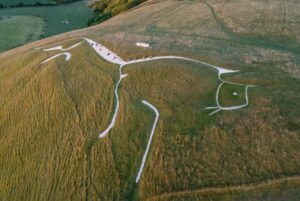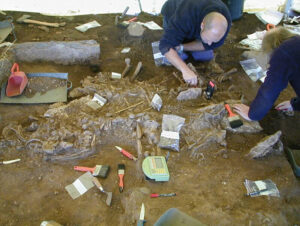The History Channel’s hit TV series Ancient Aliens and Netflix’s Ancient Apocalypse explore a peculiar branch of the discipline of archaeology: pseudo-archaeology. This shaky branch of academia continues to have a strong cult following that is unimpressed by evidence or the lack of it.
What is pseudo-archaeology?
Pseudo-archaeology pertains to “approaches which misapply, misinterpret, and misrepresent archaeological material in a non‐scientific and often speculative way,” according to the Oxford Dictionary. It interprets evidence out of context and injects bias and exaggeration to suit a particular hypothesis. Usually, pseudo-archaeology finds its roots in esoteric and religious beliefs and is often championed by self-proclaimed experts.

Bust of Plato. Photo: Marie-Lan Nguyen/Wikipedia Commons
Usually, the academic community rejects pseudo-archaeological studies because of their romantic notions. For their part, pseudo-archaeologists claim that conventional scholars are too rigid, afraid of new ideas, and hostile to the alternative possibilities out there.
Examples of this approach are numerous. Were the Egyptian pyramids built by extraterrestrials? Was Ancient Culture A somehow influenced by Ancient Culture B, despite no evidence that the two interacted? Sometimes the goal seems to be to come to an unconventional conclusion because it is simply more interesting than the conventional explanation.
A startling statistic from Chapman University, as highlighted by Lizzie Wade of science.org, shows that 57 percent of Americans believe in ancient advanced civilizations and 41 percent believe in extraterrestrial contact with these civilizations.
Cross-cultural contact
The idea of contact between ancient civilizations because of a few superficial similarities, remains popular. Supporters sometimes go to elaborate lengths to search for evidence. Norwegian adventurer Thor Heyerdahl set out on his famous Kon-Tiki Expedition in 1947 to prove that ancient South Americans journeyed to Polynesia and settled there.
While he did manage to travel 8,000km on his raft, the Kon-Tiki, DNA research in the 1990s proved that Polynesians did not originate from South America.

Wall paintings of Egyptian gods. Photo: British Library/Unsplash
Ivan Van Sertima proposed something similar. He championed the hypothesis that African voyages made their way to the Americas before Columbus and influenced cultures like the Olmec. The “evidence” for this lies mainly in art, sculptures, and the supposed voyage of a Malian king named Abu Bakr II. However, academics have rejected this.
Atlantis and the destruction of civilizations
Atlantis is undoubtedly the poster child of this type of archaeology. Its brief mention by Plato has spawned many storylines and myths. Historians agree that Plato did not refer to Atlantis as a real place but rather as an allegory. In his dialogues, he presented Atlantis as an adversary of Athens. Its greed and misuse of power prompted the gods to punish it by allowing the Atlantic to engulf it. Plato likely meant to illustrate what can happen to a corrupt nation.
As time went on, the name Atlantis started to make its way into the writings of Jewish and Christian scholars. Plato’s original intention with Atlantis often eluded them. They weren’t sure if it was a real place or a symbol. The popularity of an idyllic lost continent swallowed by the seas eventually took root in the 19th century.

Atlantis and its destruction. Illustration: Nicholas Roerich (1928-9)
Bold claims, little evidence
One of the most popular books in the field of pseudo-archaeology is Atlantis: The Antediluvian World by Ignatius Donnelly. This 1882 book makes several bold claims. Donnelly hypothesizes that ancient civilizations like the Maya, Incas, and Egyptians evolved from survivors of Atlantis after its destruction.
He also believed that Atlantis was somewhere in the Mediterranean and that these civilizations’ pagan gods and goddesses were actually citizens of the lost continent. Additionally, he tied Atlantis’s destruction to the biblical deluge.
Donnelly did not stop there. He released a follow-up called Ragnarok: The Age of Fire and Gravel. In this work, he explored his hypothesis that a meteor wiped out ancient cave-dwelling people 12,000 years ago. This resulted in catastrophes like tsunamis and ice ages. He cited evidence for this in the creation of North America’s Great Lakes and in the artworks of the ancient Greeks and other long-ago cultures.
Capitalizing on Donnelly’s hypothesis, another controversial figure named Madame Blavatsky popped up around the same time. She was a Russian mystic who became the founder of a new esoteric religion called theosophy.
Theosophy split humanity’s evolution into seven stages, or “root races.” Blavatsky perpetuated that humanity’s fourth root race lived in Atlantis, where people had psychic abilities and advanced technology. This supposedly took place around 900,000 years ago.
Pyramids
There is something about pyramids that seem to draw both archaeologists and pseudo-archaeologists like moths to a flame. Many believe that ancient civilizations like the Egyptians and Mesoamerican cultures must have possessed advanced technology or knowledge to achieve such an architectural feat. These notions began before we had a better understanding of the methods by which the Egyptians, in particular, moved these giant blocks from their original quarries to the site of the pyramids.
Most popular of all is the idea that aliens built the Egyptian pyramids, especially the Great Pyramid of Giza. This is due to the pyramid’s alignment with the constellation of Orion. However, scholars agree that pyramids exist mainly to house the remains of deceased pharaohs. While the Great Pyramid of Giza does align with stars in the Orion Belt, this most likely pertains to the afterlife in some way.
Another controversial hypothesis suggests that an ancient civilization once lived in Visoko, Bosnia, and Herzegovina, and built the so-called Bosnian Pyramids.
Leading the charge is Semir Osmanagic, a Bosnian businessman who argues that a series of pyramid-like hills in the area are remnants of the Illyrian people, who lived in the Balkans from 12,000 BC to 500 BC. In 2017, he claimed to have found evidence that the pyramids were even older, 34,000 years old, and might contain tunnel systems beneath.
Alas for this intriguing theory, geologists agree that these hills are simply “flatirons,” a common geomorphological feature with distinct triangular slopes.

Pyramids break down. Photo: Eugene Tkachenko/Unsplash
Ancient astronauts
Erich Von Daniken’s bestseller Chariot of the Gods? made a huge impact when it came out in 1968 and has since sold over 70 million copies. It even served as the main inspiration for Ancient Aliens on the History Channel. The objections of professional archaeologists cannot hope to outweigh this pop-cultural juggernaut.
Von Daniken believed that “ancient astronauts” shaped Earth’s destiny. These wise aliens visited our planet and shared advanced technologies and secret knowledge with us. The gods and goddesses of the Egyptian and Hindu pantheons, for example, were actually astronauts from distant parts of the universe. He also points out possible appearances of technologies like spacecraft in hieroglyphic art or cave paintings.
One of his most controversial claims is that the Nazca Lines in Peru were landing strips for the spacecraft of these purported astronauts. After all, the lines are mainly visible from the air. However, historians now suggest that the lines mainly served for irrigation or religious mountain worship.
Pseudo-archaeology and the end of the world
Another popular theory weaves the Mayan Calendar with the 2012 apocalypse scare. Supposedly, the Maya’s 5126-year cycle ended on 21 December 2012, when the apocalypse was to arrive. Some pseudo-astronomers predicted a possible collision with either a black hole or a rogue planet called Nibiru. While this was all fictional, it did not stop corners of the public from endlessly debating the idea. Hollywood, which never lets truth stand in the way of a good story, made a blockbuster film out of it.
Conclusion
There is a difference between open-mindedness and gullibility. Many of the above theories seem based on coincidences, superficial similarities, and biases. Pseudo-archaeology posits that our past is vastly more interesting than conventional histories suggest. Alas, the facts tell a different story.






